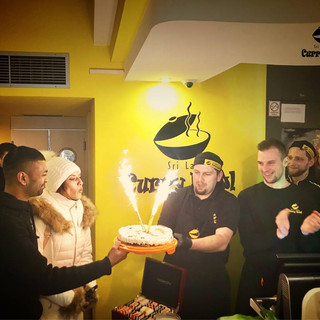Curry Bowl - Intense Food of Sri Lanka
- Vedran Obućina

- Aug 23, 2018
- 5 min read
Updated: Feb 19, 2019
Did you ever participated in a Kotthu fast eating contest? If you had not been to Curry Bowl then you probably did not, and you do not even know what the Kotthu is at all. It is a favourite street food on Sri Lanka, whose base is chopped bread with vegetables (onion, garlic, ginger, chilli, carrots, cabbage) with eggs or meat and spices. Everything is poured and mixed and served with a hot sauce. Bread - called roti - is similar to Indian chapati, or thin bread, which is common to the entire Indian subcontinent. Kotthu is made from the godhamba roti, and the spices offered to the Croatian palate are mild, hot, spicy and "you-are-not-normal" hot. The sweat runs in the streams while across the table sits smiling Clement Senaratne, who together with his brother Brian and wife Tamara runs the only restaurant in Croatia offering Sri Lankan meals.

Curry Bowl is located in Zagreb's Tkalčićeva street, with bunch of tourists roaming around, and invites every passer-by with its yellow colour that gives the atmosphere of openness, vividness and youthfulness. So is the whole restaurant, with young staff, wide smile and fun atmosphere. Clement says it is a "Curry Bowl Experience". This experience is offered to its guests from December 2015, when the Sri Lankan expats opened its first restaurant and now they operate a summer restaurant near Šibenik as well. In addition to the Sri Lankan curry and warmth, it is also known for the Kotthu challenge, where participants are competing on who will eat fastest the Kotthu and drink the Sri Lankan beer. For all the brave readers, the next competition is in October this year.
The mentioned beer is really great. We tried Lion Lager, which with its moderate 4.8 per cent alcohol was excellent for quenching thirst. This Lager won the gold medal for 2011 and 2012 at Monde Selection, which is run by a prominent Belgian brewing institution. We also had the Lion Stout, which stirred us well with his 8.8 per cent alcohol. This powerful beer is produced from British, Czech and Danish malt, Styrian hops and English yeast, yet still proudly shares the name of the Sri Lankan Beer around the world, conquering numerous awards. Lion is a real institution because it works since 1881. The beer is great, and the label with the lion is equally tempting.

Especially Lion can overcome the thirst after spicy Sri Lankan food. Often, this cuisine is identified with Indian food, but the differences are great. First of all, Indian cuisine is based on ghee, while Sri Lanka cooks on coconut milk. There are similarities, but there are also huge differences. Sri Lanka's food is unique, tastes are different but are always intense. In addition to its domestic traditions, the influences of South Indian, Indonesian, Dutch and Chinese cuisine are mixed. The food base is rice, coconut and spices, whereas Sri Lanka has become famous for its spices all over the world. In Curry Bowl, seasoning is mixed with the help of home-made spices and sauces company Volim ljuto. Here you can try original coconut water produced only on Sri Lanka. Recently, Sri Lanka is influenced by Chinese gastronomy, so the most favourite meal of Clement is a Chinese-Sri Lankan spicy mixture of seafood!
A gastronomic journey to the tastes of Sri Lanka began with a few starters. We tried a lentil soup (dhal) which was cooked with a coconut milk in a spicy version. It is mild and refreshing, with a full-flavour of lentil, but also with the curcuma background that evidently gives additional colour to this wonderful dhal. Tuna and potato cutlets are actually made as fish balls that can be dipped in spicy sauces for great taste experiments. A particularly tasty starter is a Parippu Wadai or deep fried lentil cakes, made with coconut milk, onions, sweet peppers and curcuma, and they are great with a green sauce.

The chefs and waiters know all the little secrets of the Sri Lankan cuisine without any problems. It is possible as they were taught by Sri Lankan chef Chaminda Liyanage who arrived in Croatia and started with the high-quality food training offer. Among other things, quality is expressed in curry powder that is organic and comes from Sri Lanka. Traditional Sri Lankan-style curry is served with freshly cut coconut with spices (Pol-Sambal, where coconut comes with onions, tomatoes, lemons, chilli powder, salt and sweet peppers) and with steamed basmati rice. Curry comes with coconut milk, onions, garlic, tomatoes, ginger, curry powder, chilli powder, turmeric, coriander, cardamom, cinnamon and clove, and there is probably no better knowns spice that would not go into some of the curries, although this is not an especially elaborate dish. Curry is served with chicken or mixed vegetables, but a specialty is the curry with a black pork that is lightly cooked for three hours. Pork is quite present in Sri Lanka, as this is primarily Buddhist country. There are also deviled dishes made with crispy vegetables and cooked meat sliced into a combination of sauces and spices. Served with Pol-Sambalom and basmati rice, it can come with chicken, pork, beef or vegetables. There is no need to guess why the devil is involved in the name!

It is a pleasure to sit on the terrace of Tkalča and watch the passers-by who, sometimes with compassion, look at the guests who have ordered stronger spicy food. Everyone chooses the level of hotness at their discretion, but spice has its reasons and is great to eat spicy food in the summer. Temperatures are sky-rocketing, but without tropical breeze and cold coconut water like in Sri Lanka; the centuries of gastronomic development of the entire Indian subcontinent still depends on these climatic conditions. Food at high temperatures quickly goes off, so strong spices are needed to preserve it. There is also the claim that people living in humid areas of South India and Sri Lanka eat spiced food to sweat more and balance the internal (physical) and external temperature. Books and books were written about it, but the freshness of Lion Beer helped us most!
For those who are serious in gastronomic upgrading, they will not deny y desert, with Curry Bowl offering Sri Lankan chocolate biscuit pudding served with whip cream and fresh strawberries sauce or vanilla custard with a layer of creamy caramel on top. Sweet tastes can barely cover the delicate effect of spiced Kotthu, but they confirm the main setting of Sri Lankan cuisine – intensely flavoured and just gorgeous!

If you want to try intense food in an excellent mood, visit the Curry Bowl:
Curry Bowl
Tkalčićeva 44, Zagreb, Croatia
Email: alteraesca@hotmail.com
Phone: 00 385 1 5579 175
https://www.srilankancurrybowl.com/
Gallery - all photos by Curry Bowl




























Comments